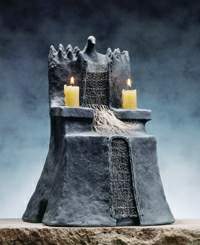Dagmar Poláčková
Mária Rudavská made her debut on the art scene during the late 1960’s, establishing herself as one of the most significant personalities of author-woven tapestry in Czechoslovakia. She demonstrated good knowledge of original folk weaving techniques in her early tapestries, connecting this to modern art trends. She only started working with clay in the second half of the 1980’s. Nevertheless, she was able to make good use of her experience from creating textile creations in her ceramic statues. She enriched her statues with techniques from tailoring, metal wire weaving, or even by adding a “woven” metal motif. At the beginning of her work with clay, she was inspired by small domestic utilitarian objects. Here, an incorporated figural motif of most commonly a female body with bird head was used to enrich the shapes of folk saltshakers or vessels for holy water. Their iconography as well as with their shape created ceramic statues – guardians, gates, cathedral, an imaginary countryside and festive places. The author depicts here remembrances from her childhood. Nature is also an inspirational source. Artistic as well as a significant transposition of the natural is also a method by which Mária Rudavská finishes the surface – natural soil colours and greys dominate. Technically perfect, she works with reduction glazing, metalising the clay surface and covering it with patina in this her balanced and typical colour scale. The author has successfully presented at the most prestigious event of the second half of the 20th Century in world art – the 1997 Biennale in Venice. She also received recognition twice – for ceramic statues (1992, 1998) at the international exhibition of ceramics in Mine, Japan.
